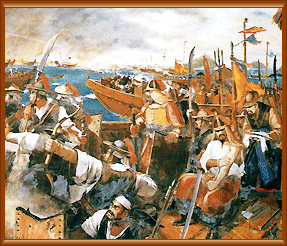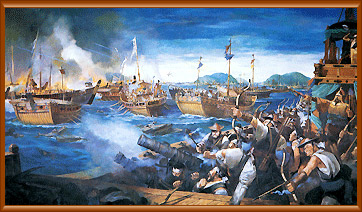Controlling the Seas by Naval Force
Immediately prior to the war, the number of battle ships that Joseon had was about 250 ships. At this time, the naval forces in Gyeongsang-do and Jeolla-do had Park Hong as the Gyeongsang Jwasusa, Won Gyun as the Gyeongsang Woosusa, Yi sun-shin as the Jeolla Jwasusa and Yi Eok-ki as the Jeolla Woosusa. However, once the war broke out, the navy in Gyeongsang-do was scattered around without having a fully blown battle that the naval force of Joseon was under the command of Jeolla Jwasusa and Woosusa and the command was made by Yi sun-shin.
In the first engagement of the battle of Yi sun-shin, Won Gyun was there to help, but it was more of Yi sun-shin alone in the battle. It was held from May 4 through 8, 1592, and Yi sun-shin had the great victory of destroying 37 Japanese battle ships in the battles of Okpo, Happo and Jeokjinpo. Damage to Joseon was one minor injury for Joseon.
The second engagement was in between May 29 to June 10. In four naval battles inSacheon, Dangpo, Danghangpo and Yulpo, it destroyed 72 battle ships of Japan, and killed 88 enemy forces. At this time, the damage to the Joseon naval force was 11 death and 26 injuries that were minor casualty compared to that of the enemy. On the second engagement of battles, Jeolla Woosusa Yi Eok-gi joined with his fleet and the united fleets were consisted of 51 battle ships along with 3 battle ships of Won Gyun. In particular, the turtle ship was used from the Sacheon Battle with the proven record of its invincibility.
The third engagement of battles was in between June 6 to 13, after approximately one month after the second engagement of battles. On the 6th, Yi sun-shin led some 90 battle ships along with Yi Eok-gi to leave the Jeolla Jwasu Base to join Gyeongsang Woosusa Won Gyun in Noryang of Namhae.
 The battle in Sacheon
The battle in Sacheon
And, it induced the great fleet of Japan that was berthed in Gyeonnaeryang to the sea of Hansando to facilitate the Hakik-jin (a strategy to surround the enemy in the formation of a cranes spreading out its wings in an attack of enemy) and shot various guns and canons to destroy 2-3 ships and the enemy tried to run away.
At this time, all of the Joseon Fleet attacked at once to destroy 7 multi-layered ships, 28 large ships, 17 mid-sized ships and 7 small ships with the great victory. Wakisak who commanded this battle barely escaped along with only about 10 battle ships. This was the famous Battle of Hansan of Yi sun-shin. With this battle, the Joseon naval force was able to control the sea and made a great influence on the war thereafter.
The Fleet of Yi sun-shin temporarily stayed in Gyeonnaeryang on the day and left on the 6th day to seek for the enemy ships. And the ships berthing in Angolpo were destroyed with the canon and other attacked from the 10 to the dawn of following day, and the remaining enemy ran away to the land was slaughtered.
 The battle in Hansan
The battle in Hansan
Thereafter, in reaching Hansando on the 12th, Won Gyun was to take care of the enemy that ran away to the land from the Battle of Hansando, and Yi sun-shin returned to Yeosu on the 13th. The Japanese force that was thoroughly defeated in the Battle of Angolpo was the navy commanded by Guki.
This third engagement of battles had approximately 100 enemy ships destroyed or captured with 250 enemy soldiers killed as the biggest victory since the war broke out, but it had to cost substantial loss of Joseon's forces. However, with the Battles of Hansando and Angolpo, Joseon was able to completely control of the sea to cut off the enemy from advancing into the west sea.
The forth engagement of battles was from August 24 to September 2. The joint fleet of Yi sun-shin went to Busanpo, the main base of the enemy battle ships and destroyed several enemy vessels in Jeolyoungdo.
Thereafter, Yi sun-shin had the turtle ship in the front to spear headed into the enemy fleet into the inner port of Busanpo where approximately 470 enemy battle ships. However, the head of Japanese force disembarked the soldiers to the shore and shoot indiscretely with the guns that the exchange of shooting ensued all day long for destroying some 100 enemy battle ships. In this battle, there were casualties of 6 killed, including the Nokdo Manho Jung Woon and 25 injured.
Thereafter, Yi sun-shin returned back to Yeosu on September 2. However, the Japanese force that had its headquarter ambushed tried to avoid the battle on the sea and operated its maneuvering as the army.
As such, the reasons for victories all battled by the Joseon naval force were attributable to stand out strategic moves of Yi sun-shin, excellent battle ships along with turtle ships and panokseons, large canons with great destruction power to undertake the naval gun strategy and others. Therefore, Yi sun-shin was able to carry out undefeated battles and the controlling of the sea by Yi sun-shin, along with the activities of voluntary military forces, was the critical factor of converting the adverse war situation for better condition for Joseon.